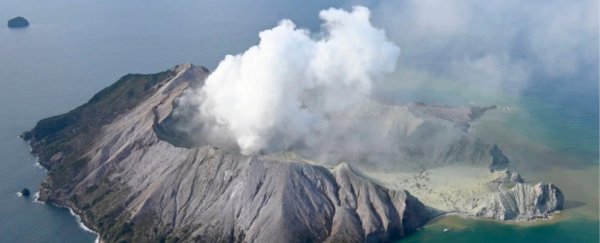For centuries — and long before Mount Doom drew Tolkien's heroes to Mordor — New Zealand's explosive geology has awed and terrified the island's residents.
Volcanoes, including the one immortalized in film adaptations of the Lord of the Rings, created the archipelago that is home to the Kiwi country. One day, they may wipe it out.
The Monday eruption of White Island, New Zealand's most consistently active volcano, killed at least six and injured more than two dozen people. It was a painful reminder of the danger behind the country's stunning, and sometimes surreal, landscapes: the ever-present possibility of another eruption.
"It's not a matter of if, it's a matter of when and where," said Janine Krippner, a volcanologist and New Zealand native who works with the Smithsonian Institution's Global Volcanism Program. "Having a true respect for all the hazards we have and how they contribute to society is really important."
New Zealand has volcanoes aplenty, Krippner said, especially considering its size and geologic age. It lies along the volatile Ring of Fire, the belt of tectonic boundaries responsible for most of the world's earthquakes and eruptions, and experts consider it a very active corner of the planet. As with so many of nature's most powerful forces, it is both boon and burden.
"New Zealand, especially its North Island, is just riddled with volcanoes," said volcanologist and science journalist Robin Andrews. "They've carved out one of the most naturally beautiful places on Earth, but at the same time, it's prone to devastating earthquakes and horrific volcanic eruptions. It's the price tag of that."
That White Island, known also by its indigenous Maori name, Whakaari, erupted is not surprising, Andrews and Krippner both said. The island, which is the tip of an undersea volcano, has seen similar explosions in recent years, but they happened to be at times when tourists and guides were not visiting the uninhabited destination, located in the Bay of Plenty off the North Island's northeast coast.
The outsize impact of the relatively small eruption underscored the unpredictable perils future events may pose.
Volcanic activity in New Zealand significantly predates human life, but in the past several hundred years, eruptions have wrought destruction across the country. In 1886, all three peaks of Mount Tarawera, on the North Island, erupted in the middle of the night, in a violent phantasmagoria of intense lightning, earthquakes, fountains of lava and a cloud of ash stretching six miles high.
The eruption was New Zealand's deadliest, killing at least 120 people and burying settlements and villages.
Thirty years later, the White Island surprised a group of sulfur miners after a crater wall collapsed and sent a molten mudflow, known as a lahar, streaming over the miners, killing 10. The only survivor, historians say, was a camp cat discovered weeks later and known thereafter as Peter the Great.
On Christmas Eve in 1953, a lahar from Mount Ruapehu swept away a bridge, causing an express train to run off the tracks. The train, traveling roughly the length of the North Island, from Auckland to Wellington, was a little over halfway to its destination, when several of its cars plunged into a river below. More than 150 were killed in what the Auckland Star called the "Nation's Greatest Rail Disaster" in a front-page story on Boxing Day.
The disaster, the paper reported, "has cast the deep shadow of grief over the whole country's observance of Christmas."
In recent years, eruptions at Ruapehu and Mount Tongariro, also near the center of the North Island, have jolted New Zealanders, but haven't led to additional casualties.
Volcanoes have helped shape the country — in more ways than just its topography. In Maori tradition, volcanoes, including Ruapehu and Tongariro, are sacred, former gods and warriors. They've also left very fertile soil, Krippner said, leading to thriving farming and agriculture.
They also attract tourists and filmmakers such as Peter Jackson, who used Mount Ngauruhoe as a stand-in for Mount Doom in his three Lord of the Rings movies.
"It has a lot of influence, not only on the landscape, but on how our country has shaped its economy," Krippner said.
As with earthquakes, also a major hazard in New Zealand, advances in science and engineering have improved how societies deal with the inevitable and adverse effects of volcanoes. It's important that buildings are built to code, with roofs that can hold up under heavy showers of ash, Krippner said. Evacuation routes and civic coordination must also be meticulously planned, she added.
"Having a nation that is prepared, and there are a lot of people working very hard toward that happening, is incredibly important," Krippner said.
Yet, when a pyroclastic flow — a devastatingly hot and fast wave of rock and gas — is barreling toward a population center, there's really only one viable option: "The best thing you can do is just tell people to get out of the way," Andrews said.
But, scientists have said, there is still much to learn about volcanoes, and forecasting eruptions remains difficult, further complicated by the vast span of geological time.
"It could be tens of thousands of years before anything happens again," Andrews said, speaking about future eruptions at New Zealand's Lake Taupo, a supervolcano known to be one of the most violent in the world. "It could happen tomorrow, or never. Everyone wants certainty in life, but when it comes to things like volcanoes, the inherent rule is: We don't know."
But at least one thing, he conceded, is known.
"Volcanism in New Zealand will continue beyond human life," Andrews said. "We are the window dressing for them, it's not really the other way around."
2019 © The Washington Post
This article was originally published by The Washington Post.
